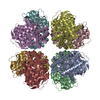+Search query
-Structure paper
| Title | Deep-branching evolutionary intermediates reveal structural origins of form I rubisco. |
|---|---|
| Journal, issue, pages | Curr Biol, Vol. 33, Issue 24, Page 5316-55325.e3, Year 2023 |
| Publish date | Dec 18, 2023 |
 Authors Authors | Albert K Liu / Benjamin Kaeser / LinXing Chen / Jacob West-Roberts / Leah J Taylor-Kearney / Adi Lavy / Damian Günzing / Wen-Jun Li / Michal Hammel / Eva Nogales / Jillian F Banfield / Patrick M Shih /    |
| PubMed Abstract | The enzyme rubisco (ribulose-1,5-bisphosphate carboxylase/oxygenase) catalyzes the majority of biological carbon fixation on Earth. Although the vast majority of rubiscos across the tree of life ...The enzyme rubisco (ribulose-1,5-bisphosphate carboxylase/oxygenase) catalyzes the majority of biological carbon fixation on Earth. Although the vast majority of rubiscos across the tree of life assemble as homo-oligomers, the globally predominant form I enzyme-found in plants, algae, and cyanobacteria-forms a unique hetero-oligomeric complex. The recent discovery of a homo-oligomeric sister group to form I rubisco (named form I') has filled a key gap in our understanding of the enigmatic origins of the form I clade. However, to elucidate the series of molecular events leading to the evolution of form I rubisco, we must examine more distantly related sibling clades to contextualize the molecular features distinguishing form I and form I' rubiscos. Here, we present a comparative structural study retracing the evolutionary history of rubisco that reveals a complex structural trajectory leading to the ultimate hetero-oligomerization of the form I clade. We structurally characterize the oligomeric states of deep-branching form Iα and I'' rubiscos recently discovered from metagenomes, which represent key evolutionary intermediates preceding the form I clade. We further solve the structure of form I'' rubisco, revealing the molecular determinants that likely primed the enzyme core for the transition from a homo-oligomer to a hetero-oligomer. Our findings yield new insight into the evolutionary trajectory underpinning the adoption and entrenchment of the prevalent assembly of form I rubisco, providing additional context when viewing the enzyme family through the broader lens of protein evolution. |
 External links External links |  Curr Biol / Curr Biol /  PubMed:37979578 PubMed:37979578 |
| Methods | EM (single particle) |
| Resolution | 2.21 Å |
| Structure data | EMDB-41946, PDB-8u66: |
| Chemicals |  ChemComp-MG:  ChemComp-CAP:  ChemComp-HOH: |
| Source |
|
 Keywords Keywords |  LYASE / LYASE /  Carboxylase / Carboxylase /  Oxygenase Oxygenase |
 Movie
Movie Controller
Controller Structure viewers
Structure viewers About Yorodumi Papers
About Yorodumi Papers





 bacillota (low GC Gram+)
bacillota (low GC Gram+)